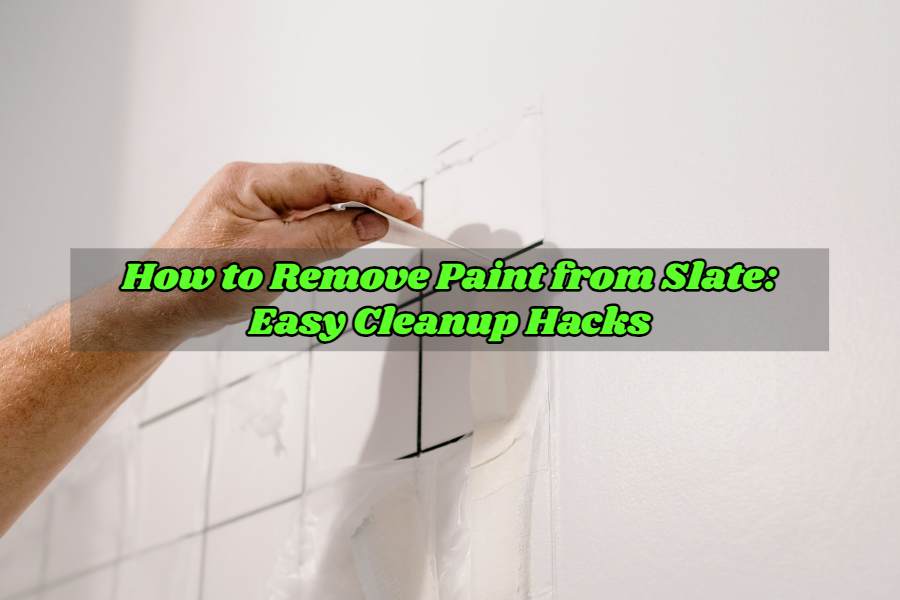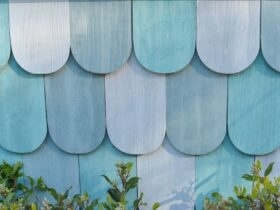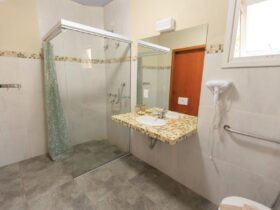To remove paint from the slate, gently apply a mixture of water and mild detergent and use a soft brush. For stubborn spots, carefully use a plastic scraper or rubbing alcohol.
Removing paint from the slate requires a delicate touch to preserve the stone’s integrity. Slate, a natural and durable material, often graces floors, roofs, and outdoor walkways, where it can inadvertently collect paint drips. Due to its porous nature, slate can absorb paint, making the removal process tricky.
Homeowners and DIY enthusiasts face this challenge hoping to restore the slate’s natural beauty without causing damage. While commercial paint removers are available, they may be too harsh for slate, which is why milder solutions are often recommended. This guide aims to provide effective methods for cleaning paint off of slate, allowing you to revive your stone surfaces without the need for professional intervention. With the right technique and some patience, you can successfully tackle paint stains and maintain the slate’s elegant appearance.
Introduction To Paint Removal From Slate
Removing paint from the slate involves careful steps. Slate is a delicate stone that can enhance your home’s beauty. But sometimes, paint spills occur. To restore the slate’s natural look, you must remove paint safely and effectively.
The Challenges With Slate
Slate is not like other stones. It’s soft and can scratch easily. You must choose the right method to avoid damaging it. Many cleaning agents are too harsh for slate. Always opt for gentler solutions.
- The soft nature of slate
- Sensitivity to harsh chemicals
- Risk of scratching or etching
Precautions Before Starting
Before removing paint, take certain precautions. Wear protective gear like gloves and safety glasses. Ensure the room is well-ventilated. Test the cleaning solution on a small, hidden area first.
- Wear gloves and safety glasses
- Ensure good ventilation
- Test cleaning solution on a hidden spot
Identifying The Paint Type
Before removing paint from slate, it’s vital to know the type of paint. This knowledge shapes the approach for effective paint removal. Test a small area first, to ensure no damage to the slate. There are simple ways to tell which kind of paint you’re dealing with.
Water-based Paints
Water-based paints are easier to remove. They’re often used for household walls and crafts. Check for water solubility. Rub a damp cloth on the paint. If color comes off, it’s likely water-based. Here are clues that paint is water-based:
- Clean up methods include soap and water.
- It has a light, almost milky smell.
- The label may mention “latex” or “acrylic.”
To remove water-based paints from slate, use warm water and a mild detergent.
Oil-based Paints
Oil-based paints need a different approach. They are commonly found on outdoor structures and art projects. These clues indicate oil-based paint:
- Thinner or mineral spirits are required for cleanup.
- It has a distinct, sharper smell than water-based paints.
- The label might include “oil” or “alkyd.”
Use a solvent designed for oil-based paints. Apply it to a cloth and dab the paint spot. Test carefully, as solvents can affect the slate’s finish.
Essential Tools And Materials
Tackling the challenge of removing paint from slate requires the right tools and materials. Whether you’re dealing with a recent spill or an old paint job, the process can be straightforward with the essential items on hand. Let’s explore what you’ll need to tackle the job safely and effectively.
Safety Equipment
Safety comes first, always. Before starting, equip yourself with these safety items:
- Gloves: To protect your hands from chemicals and sharp edges.
- Goggles: Prevent splashes of cleaning agents from reaching your eyes.
- Respirator mask: Keep harmful fumes at bay.
- Long-sleeve shirt and pants: Shield your skin from any irritants.
Cleaning Agents
Various cleaning agents can effectively remove paint from slate. Consider these options:
| Agent Type | Usage |
|---|---|
| Water | Mild cases or thin layers. |
| Paint stripper | Thicker, stubborn paint layers. |
| Soap solution | For gentle cleaning after paint removal. |
| Rubbing alcohol or acetone | For spot treatment and residue. |
Scrapping Implements
Using the right tools is crucial to avoid damaging the slate. These implements should help:
- Plastic scrapers: Scrape off paint without scratching the slate.
- Soft-bristle brush: Clean off loose paint and debris gently.
- Putty knife: Remove larger sections of softened paint carefully.
- Steel wool: Polish and smooth the surface once paint is removed.
Step-by-step Removal Process
Removing paint from slate requires precision to maintain its natural beauty. The process can be straightforward with the right steps. Follow this guide for effective paint removal from slate surfaces.
Prepping The Area
Start with safety and space. Protect surrounding areas and wear gloves. Place drop cloths to catch debris. Ensure good ventilation.
Softening The Paint
Use a paint stripper for slate. Apply according to the label. Let it sit but watch for slate damage. The paint should bubble.
Scrapping Techniques
- Choose plastic scrapers – they are less harsh than metal.
- Gently scrape the softened paint.
- Begin from the edges and move inwards.
- Avoid heavy pressure to prevent scratches.
Slate Surface Finishing
Clean the slate with a mixture of water and mild detergent. Use a soft brush and rinse well. Dry with a clean towel.
Natural And Homemade Solutions
Removing paint from slate doesn’t require harsh chemicals. Natural and homemade solutions can be just as effective. These methods are safe, eco-friendly, and often use products found around the home. Let’s explore some of these gentle yet effective approaches.
Vinegar And Baking Soda
Vinegar and baking soda work wonders on stubborn paint. They create a powerful natural reaction that can lift paint without damage to the slate.
- Mix equal parts white vinegar and water in a bowl.
- Add baking soda slowly to create a paste.
- Apply to the painted area and let it sit for several minutes.
- Scrub gently with a soft-bristle brush.
- Rinse with clean water and dry.
Soap And Water Approach
Sometimes, simple soap and water can remove fresh paint spills on slate. This method is best for non-set paint.
- Prepare a solution of mild dish soap and warm water.
- Soak a soft cloth in the mixture.
- Dab the paint spill gently.
- Use a clean cloth with water to rinse.
- Pat the area dry with a towel.
Troubleshooting Common Problems
Removing paint from slate might seem straightforward, but sometimes you hit a snag. Common problems can arise, like stains or rough textures. Knowing how to tackle these issues will restore your slate’s beauty. Let’s explore effective solutions together.
Stains After Removal
Even after painstakingly removing paint, stains often remain. The key is acting quickly. Use a poultice made with baking soda and water. It extracts the stains from the slate. Here’s what you do:
- Mix the ingredients to form a thick paste.
- Apply the paste to the stained area.
- Cover with plastic wrap and let sit for 24 hours.
- Rinse with water and pat dry.
Rough Slate Textures
The texture of slate can become rough after paint removal. Smooth it out without causing damage:
- Gently sand the area with fine-grit sandpaper.
- Clean the dust with a soft-bristled brush.
- Seal the slate to protect future wear.
Preventing Paint Splatters
Prevention is better than a cure. Keep your slate paint-free by:
- Covering slate surfaces before a paint job.
- Using painter’s tape to shield edges and crevices.
- Keeping cleaning supplies on hand for quick action.
Maintaining Your Slate Post-cleanup
After successfully removing paint from your slate, preserving its natural beauty becomes priority. A well-maintained slate surface can enhance your home’s appeal and stand the test of time. Follow these simple steps to ensure your slate remains in pristine condition.
Regular Cleaning Tips
To keep your slate surfaces looking their best, adopt a routine cleaning regimen. Dirt and grit can scratch slate, so it’s important to address spills quickly and sweep regularly.
- Dust or sweep slate floors weekly.
- Use a damp mop with a gentle cleaner for deeper cleans.
- Avoid acidic cleaners, as they can etch the stone.
Protecting Slate From Future Spills
While accidents happen, taking proactive steps can minimize damage from future spills. Proper sealing and careful placement of rugs can make a big difference.
| Protection Method | Frequency | Tips |
|---|---|---|
| Sealing | Every 1-3 years | Choose a sealant suitable for slate to create a barrier against stains. |
| Use of Rugs | As needed | Place rugs in high traffic areas to catch drips and dirt. |
| Immediate Cleanups | Immediately after spills | Gently blot spills to prevent stains. |

Credit: naturesnurtureblog.com
Frequently Asked Questions Of How To Remove Paint From Slate
How Do You Remove White From Slate?
To remove white marks from slate, gently scrub the area with a soft brush dipped in a mixture of water and vinegar. Rinse thoroughly with clean water after scrubbing. For persistent stains, applying a commercial slate cleaner as per the manufacturer’s instructions may be necessary.
What Is The Best Cleaning Solution For Slate?
The best cleaning solution for slate is a mixture of warm water and mild dish detergent. Avoid acidic cleaners to protect the slate’s integrity.
How Do You Remove Paint From A Slate Fire Surround?
Begin by gently scraping off any loose paint with a plastic scraper. Apply a small amount of paint stripper to remaining paint, following the product’s instructions. Wipe away the dissolved paint with a soft cloth, then clean the slate with mild soap and water to finish.
Can You Use Mineral Spirits On Slate?
Yes, you can use mineral spirits on slate to clean tough stains, but use sparingly and rinse thoroughly after application. Always test in an inconspicuous area first.
Conclusion
Removing paint from slate need not be daunting. By now, you’re equipped with safe, effective methods. Whether it’s a gentle rub or a deeper cleanse, restoring your slate’s beauty is doable. Remember to protect the stone’s integrity while cleaning. Start your project confidently and watch your slate surfaces return to their original splendor.








Leave a Reply